Advance on Leith - 31st July 1650
We played these two games at Call to Arms back in August 2019....
Parliament Briefing
Between Edinburgh and the border with England, the Scots adopted a scorched earth policy, thus forcing Cromwell to obtain all of his limited supplies from England, mostly arriving by sea through the small port at Dunbar. Knowing that his logistical problems would only increase over time Cromwell decided that a rapid advance to attempt to take Leith, Edinburgh’s nearest port, was the best way to solve his supply problems. Such a move would also force the Scots to fight and, if successful, help bring an early end to Charles II’s royalist aspirations. To lead the advance on Leith Cromwell decided to put Major General Lambert’s experienced brigade of horse and Colonel Monck’s infantry brigade in the van, with Lambert in command. Cromwell’s own brigade of horse would stay in reserve to start with, eventually deploying where he thought most advantageous once the Scots army’s deployment became apparent to the English. To support Lambert’s opening attack Cromwell ordered an artillery battery be established on the Eastern most heights of Arthur’s Seat prior to the attack. This battery could then dominate the Scots trenched defences and would be defended by a detachment of foot drawn from Mauleverer’s Foot.Covenant Briefing
Leslie initially showed no inclination to fight Cromwell’s advancing force on the open ground East of Arthur’s Seat, the large, long extinct volcano that dominates the surrounding low lying coastal plain. Despite Leslie’s superior numbers, Cromwell’s reputation, together with the variable military experience of his own men led him to believe he could use the strength of his defences to greater effect. Why risk fighting in the open when the English could waste their strength against them? In fact, he had already made good use of Edinburgh’s natural features, placing an outpost on Arthur’s Seat overlooking Holyrood House. By far the most notable of his man-made defences was a multiple line of trenches, in front of which spears were embedded in the ground to counteract charges from cavalry. These ran from the port of Leith in the north along the path of the present Leith Walk to Holyrood. However, his defensive plans were thwarted by the continuing interference from the Kirk and the all powerful Committee of the Estates, both of who insisted that Cromwell’s force be engaged before reaching Edinburgh’s defences. Unphased, Leslie acted swiftly to put together a plan to counter Cromwell’s bold move using roughly half the total forces at his disposal. Two brigades of lowland infantry, commanded by Colonel Sir James Campbell of Lawers and Colonel John Innes respectively, would advance to the east to confront Cromwell’s forces as they advanced on Leith, supported by the Earl of Leven’s cavalry brigade and long-range fire from field artillery deployed within the Scots defences. A detachment from Campbell of Lawer’s regiment would hold the Eastern slopes of Arthur’s seat against any English intervention. Meanwhile a further cavalry brigade under the command of Major General Sir Robert Montgomerie would take the road round the south of Arthur’s Seat to Jock’s Lodge and fall on the advancing English from their left flank and rear.Game 1 – Covenant (Peter) and Parliament (Paul)
The battlefield, with Arthur’s Seat nearest the camera and the Scots trenches on the left:

The Scots deployment:

The English arrive, Monck’s infantry on the left and Lambert’s cavalry on the right:
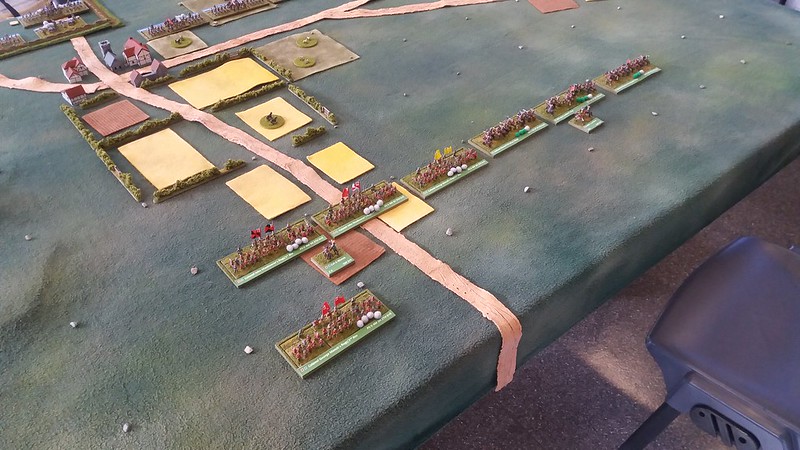
Lambert’s brigade advanced briskly across the open heathland and was engaged by the Earl of Leven’s small brigade made up of the Earl’s own bodyguard of Dutch style Cuirassiers and Lord Brechin’s Lancers. The Earl’s bodyguard is quickly overwhelmed by Lambert’s veteran regiment, though not before Lambert himself takes a pistol ball in the shoulder, seriously wounding him and forcing him to retire from the field, leaving the English leaderless until Cromwell himself arrives on the scene. Meanwhile after a stiff fight Brechin’s Lancers rout Colonel Edward Whalley’s Regiment.

As it pursues Whalley’s Horse Brechin’s Lancers is in turn flanked by Fleetwood’s Horse (left hand side). Somewhat fortuitously they fail to score a single hit on my unit and I can turn to face them, meanwhile Monck advances most of his brigade forward, leaving a single battalia to guard the road to Jock’s Lodge (very top right). I advance to the meet them (hope those sheep move out the way…).

Montgomerie’s cavalry brigade arrive from the south and I charge the lone infantry battalia in the rear repeatedly, but only inflict a single hit….I need three to destroy it.
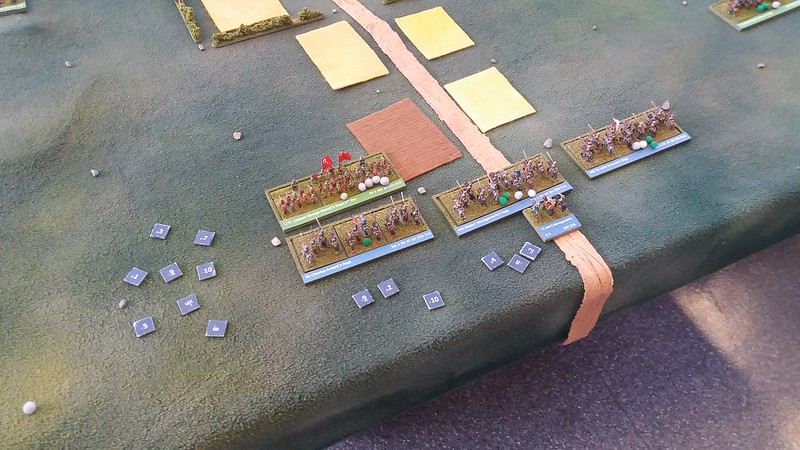
While Montgomerie is busy trying to break into the English infantry formation Cromwell’s cavalry arrive to save the day…..literally.

There is a huge scrap between the two cavalry brigades. When the smoke clears two of the Scots regiments have disintegrated and Arnott’s Lancer’s still can’t get the last hit on Monck’s veteran foot in order to destroy it. The next turn they themselves take a further hit and are removed since they are a two hit unit.

In the centre the two infantry forces come to grips indecisively. Its handbags at close quarters but the English do not manage to roll up the raw Scots units. The Artillery and forlorn hopes on Arthur’s Seat exchanged a bit of fire during the game but with their brigade commanders both having higher priorities elsewhere there was not a lot of action on that side of the table.
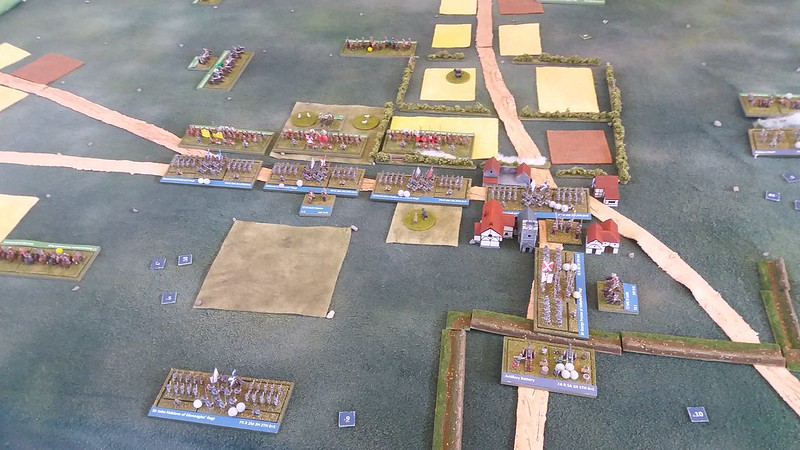
With the destruction of Montgomerie’s and Leven’s brigade I handed over the last of my victory medals, giving a final total of 12 to 8 to the English.
I was very happy how the scenario played out and the result was about what I would have expected. We both had occasions where units saved 3 hits in one turn, while in other turns seemingly no one could hit a thing, especially amongst the infantry. We’ve played enough FK@P now to be quite familiar with the rules and I do like the period feel that they give. It was really great to be able to finally play a game with the Scots as I first became interested in them many years ago but other projects and events have always precluded getting on to them till we found the right combination of scale and rules last year.
Game 2 – Covenant (Paul) and Parliament (Peter)
After lunch we swapped sides and played again. Deployment was pretty much as the first game:
I decided to attack from the outset in order to avoid Monck’s brigade being pinned by the flank marching Scots cavalry. Lambert’s veterans spurred forward towards the enemy and charged in fearlessly. Monck’s brigade soon followed, crashing into the Scots line to Lambert’s left:

Things didn’t go quite to plan from the start….Brechin’s Lancers rode down Fleetwood’s Horse and Lambert’s charge against Forbes’s raw and untried foot battalia only caused two hits. Even Leven’s small bodyguard was able to initially withstand Lambert’s charge at the head of Whalley’s Horse.
Monck’s men didn’t do much better, inflicting only single hits, while Mauleverer’s veteran 2nd battalia reels from two hits from their opponents….ouch! The English need something to go to plan…
Cometh the hour cometh the man…….Cromwell and his cavalry brigade duly arrive, though he failed to activate very successfully despite his re-roll and Montgomerie’s Scots cavalry brigade gallops onto the field to Cromwell’s left, eager to engage:

Cromwell’s left most unit, Colonel Robert Lilburne’s Regt of Horse is flanked and easily rolled up by Arnott’s Lancers. Next turn Cromwell, at the head of his own regiment, is able to return the favour:

Before he himself is lightly wounded and is forced to join his last remaining unit, the aptly named Hacker’s Horse, as Montgomerie’s Lancers turn Cromwell’s men to chaff (“they were like chaff before our swords” or whatever the saying is):

Meanwhile in the front line Monck’s and Lambert’s men were still looking to push through the Scots infantry…

By this time Whalley’s Horse had destroyed Leven’s small bodyguard and Lambert’s Horse would eliminate Forbes of Leslie’s foot, but they pursued off the table and are not returning anytime soon. In turn the General of Artillery’s regiment inflicted a third and fatal hit on Mauleverer’s 2nd battalia…..another 3 VP lost to the Scots….I am running out of units fast. The other Scots infantry I am fighting are taking hits but hang on doggedly.
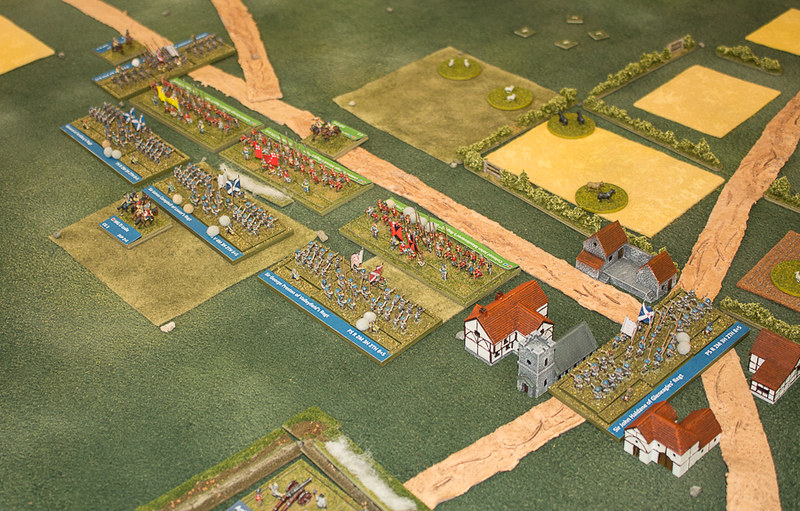
Monck’s three remaining battalia attempt to push through the Scots defenders. Note that all three of the Scots units facing them only have one hit left….but for at least two turns no one hits anyone and Innes’ regiment attempts to flank Monck’s right hand unit.
But help is at hand as Cromwell manages to outdistance Montgomerie’s pursuing cavalry and charges into the flank of Innes’ Regiment. Its handbags at zero paces again as no hits are made by either unit and Innes is able to turn to face Hacker’s attack.
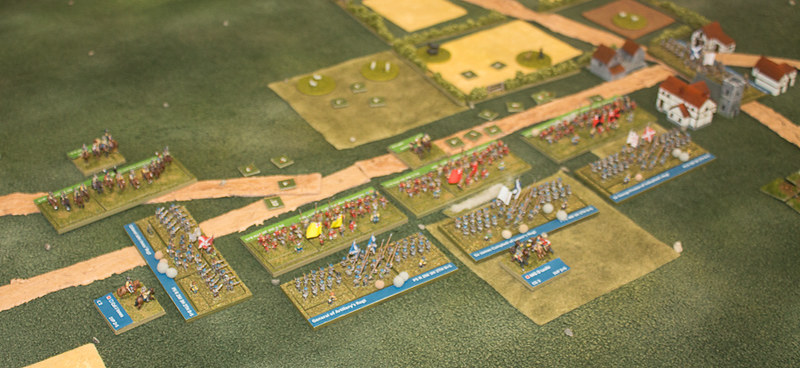
The next turn I managed to finally destroy Campbell of Lawer’s Regiment (the middle Scots unit) but Monck’s left battalia is also lost, leaving me 1VP from defeat.

The final chapter is played out on the right, where Hacker’s Horse live up to their name by again failing to get the one hit they need to destroy Innes’s Foot, who go one better and inflict a second hit on the English regiment which is enough to remove it. Cromwell rides off the battlefield with his retinue, pondering if the invasion of his former ally was a good move after all and promising himself that a Parliamentary Inquiry would be held into the English army's suppliers to ensure that for the next campaign they were properly equipped with steel rather than rubber swords.
The game could have either way since so many of Paul’s units only needed a single further hit to be removed. (I didn’t count the final score but it was about 12 – 6 or so if I remember correctly as I did remove some Scots units).
So two games each with a fairly close result and one win to each side…….developing and playing the scenario was very rewarding for me and we got some good feedback from visitors and passing gamers, so no complaints from me overall, though actually winning a scenario I wrote would be novel
No comments:
Post a Comment